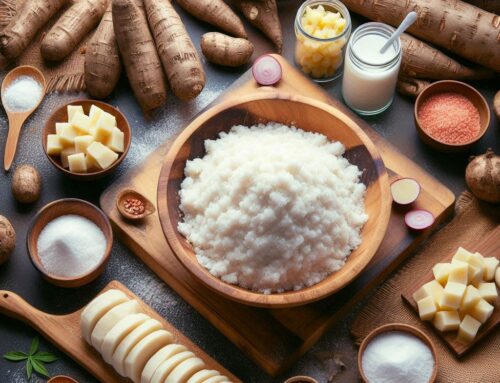
Introduction: The Benefits of Using Cassava as Pig Feed
Cassava, a versatile root crop, is gaining recognition as an effective alternative in livestock feed, particularly for pigs. The benefits of using cassava as pig feed are numerous and noteworthy. One of the primary advantages is its high carbohydrate content, which provides a substantial energy source for pigs. Cassava is rich in starch, making it an excellent substitute for traditional grains like corn.
In terms of pig nutrition, cassava offers more than just energy. It contains essential minerals and vitamins that contribute to the overall health and growth of pigs. Additionally, cassava can be processed into various forms—such as chips or pellets—making it easy to incorporate into existing feeding regimes.
Another significant benefit is that cassava serves as a cost-effective livestock feed alternative. In regions where cassava is abundant and affordable compared to conventional grains, utilizing it as feed can reduce overall feeding costs without compromising nutritional quality.
Moreover, incorporating cassava into pig diets supports sustainable farming practices by diversifying feed sources and reducing dependency on single-crop feeds. This diversification can lead to more resilient agricultural systems capable of withstanding market fluctuations or supply chain disruptions.
Overall, the use of cassava as pig feed presents a promising opportunity for farmers looking to optimize nutrition while managing costs effectively.
Understanding Cassava: Varieties and Nutritional Value
Cassava, a staple crop in many tropical regions, is an incredibly versatile root vegetable with significant nutritional value. Understanding the different types of cassava and their nutrient profiles is essential for making informed dietary choices.
There are primarily two types of cassava: sweet and bitter. Sweet cassava contains lower levels of cyanogenic glycosides, making it safer for direct consumption after minimal processing. In contrast, bitter cassava has higher levels of these compounds and requires thorough preparation to remove toxins before it can be safely consumed.
Nutritionally, cassava is rich in carbohydrates, providing a quick source of energy. It contains essential nutrients such as vitamin C, which supports immune health, and small amounts of B vitamins like folate and niacin that aid in metabolism. While low in protein and fat, its high carbohydrate content makes it an important energy source in many diets.
Understanding the nutritional content of cassava helps consumers make balanced dietary choices while appreciating this vital crop’s role in global food security. Whether choosing sweet or bitter varieties, proper preparation ensures that you can enjoy the benefits of this diverse root vegetable safely.
The Importance of Proper Preparation to Ensure Safety and Nutrient Retention
In the realm of animal feed, ensuring safety and nutrient retention is paramount. One critical aspect that requires careful attention is the preparation of cassava, a common feed ingredient. Cassava contains naturally occurring cyanogenic compounds that can release cyanide, posing a risk to animal health if not properly detoxified. Therefore, understanding and implementing effective detoxifying methods is essential.
To mitigate the risks associated with cyanide in cassava, several preparation techniques can be employed. Soaking and fermenting cassava roots are traditional methods that help reduce cyanide content significantly. These processes allow for the breakdown of cyanogenic compounds through enzymatic activity, making the feed safer for consumption.
Beyond safety concerns, preserving the nutritional value of cassava during preparation is equally important. Nutrient preservation methods such as drying and proper storage play a crucial role in maintaining the quality of animal feed. By minimizing nutrient loss during processing and storage, farmers can ensure that their livestock receives a balanced diet rich in essential vitamins and minerals.
Overall, proper preparation techniques not only enhance safety in animal feed but also contribute to optimal nutrient retention. By adopting these practices, farmers can safeguard their livestock’s health while maximizing the nutritional benefits of cassava as a valuable component of animal diets.
Step-by-Step Guide to Preparing Cassava for Pig Feed
Selecting the Right Type of Cassava:
Cassava is a versatile and cost-effective feed option for pigs, but it’s essential to prepare it correctly to ensure the health and productivity of your livestock. Whether you’re dealing with bitter or sweet varieties, each requires specific handling to maximize nutritional benefits while minimizing potential risks.
1. Selection of Variety: Start by choosing the appropriate cassava variety. Sweet cassava is generally preferred for pig feed due to its lower cyanogenic compound content, which makes it safer for direct consumption. However, bitter varieties can also be used if processed properly.
2. Peeling and Cleaning: Both bitter and sweet cassava roots must be thoroughly peeled and cleaned. This step removes dirt and reduces the cyanide content found in the outer layers of the root.
3. Chopping or Grating: Once cleaned, chop or grate the cassava roots into smaller pieces. This increases the surface area for drying or further processing, helping to reduce any remaining toxic compounds more effectively.
4. Drying Process: Drying is crucial, especially for bitter varieties that contain higher levels of cyanogenic glycosides. Spread the chopped cassava under sunlight until it reaches a moisture content suitable for storage—usually around 10-12%. This process can take several days but significantly decreases toxicity levels.
5. Fermentation (Optional): For those using bitter varieties, an additional fermentation step can help further detoxify cassava by breaking down residual cyanide compounds. Soak chopped pieces in water for 3-5 days before drying them again.
6. Grinding into Flour: Once dried completely, grind the cassava into flour using a miller or grinder suitable for animal feed preparation.
7. Mixing with Other Feed Ingredients: Cassava flour should not exceed 30-40% of total pig feed composition due to its low protein content compared to other grains like corn or soybean meal. Mixing with protein-rich supplements ensures a balanced diet that supports growth and development in pigs.
By following these steps carefully when preparing either sweet or bitter cassava varieties as pig feed, you provide your livestock with a safe and nutritious dietary option that capitalizes on this abundant agricultural resource’s economic advantages.
Cassava Harvesting and Handling
Cassava is a valuable resource for pig feed due to its high carbohydrate content and cost-effectiveness. However, preparing cassava properly is essential to ensure its nutritional benefits and safety for pigs. Below is a step-by-step guide to help you prepare cassava efficiently.
1. Harvest Timing: The first step in preparing cassava for pig feed is determining the right time to harvest. Ideally, cassava should be harvested between 8 to 12 months after planting when the roots have reached their optimal size and starch content. Harvesting at this stage ensures maximum nutritional value and minimizes waste.
2. Proper Handling Techniques: Once harvested, handle the cassava roots with care to prevent bruising or damage, which can lead to spoilage. Immediately after harvesting, clean the roots thoroughly by removing dirt and debris using water or a brush.
3. Peeling and Chopping: After cleaning, peel the cassava roots carefully using a sharp knife or peeler. This step is crucial as it removes the outer layer that may contain anti-nutritional factors like cyanogenic glycosides. Once peeled, chop the roots into small pieces or slices; this increases surface area for drying and makes it easier for pigs to consume.
4. Drying Process: To enhance shelf life and reduce toxicity levels further, dry the chopped pieces under sunlight or use an artificial dryer if available. Ensure that they are spread out evenly on drying racks or trays in a well-ventilated area until they reach a moisture content of about 10-12%.
5. Grinding into Meal: Once dried thoroughly, grind the pieces into meal form using a miller or grinder suitable for animal feed production. This process not only makes it easier for pigs to digest but also allows you to mix it with other feed components if needed.
By following these steps carefully—focusing on harvest timing and proper handling techniques—you can effectively prepare cassava as pig feed while maximizing its nutritional benefits and ensuring safety for your livestock.
Cassava Peeling and Chopping
Preparing cassava for pig feed involves several crucial steps to ensure it is safe and nutritious for the animals. The process begins with the washing process, which is essential for removing dirt, debris, and any potential toxins from the cassava roots. Thoroughly wash the cassava in clean water, using a brush to scrub off any stubborn soil or contaminants that may cling to the surface.
Once the cassava is clean, it’s time to focus on chopping methods for easier processing. Chopping not only aids in reducing preparation time but also ensures that pigs can easily consume and digest the feed. Start by peeling off the tough outer skin of the cassava roots. Then, using a sharp knife or a mechanical chopper if available, cut the peeled cassava into small chunks or slices. This step is crucial as smaller pieces will cook more evenly and are easier for pigs to chew.
By following these steps meticulously—beginning with an effective washing process and employing efficient chopping methods—you can prepare high-quality cassava feed that supports healthy growth in pigs while maximizing nutritional benefits.
Cassava Fermentation or Boiling
Cassava is a valuable feed source for pigs due to its high carbohydrate content, but it must be prepared carefully to ensure safety. Raw cassava contains cyanogenic glycosides, which can release cyanide—a toxic compound—when consumed. Therefore, proper preparation methods like boiling or fermenting are crucial to eliminate these toxins.
To begin with, the cassava roots should be thoroughly washed and peeled. Peeling helps reduce the toxin levels as most of the harmful compounds are concentrated in the skin. Once peeled, the roots can be chopped into smaller pieces to facilitate even cooking or fermentation.
Boiling is one of the most effective methods for detoxifying cassava. Place the chopped pieces in a large pot of water and bring it to a boil. The cassava should be boiled for at least 30 minutes, during which time much of the cyanide content will dissipate into the water. After boiling, drain and rinse the cassava pieces with fresh water before feeding them to pigs.
Alternatively, fermenting can also help reduce toxin levels while enhancing nutritional value. To ferment cassava, immerse it in water for several days—typically three to five—allowing natural fermentation processes to occur. This method not only breaks down toxins but also improves digestibility and nutrient availability.
Both boiling and fermenting are effective safety preparation methods that ensure cassava is safe for pig consumption while maximizing its nutritional benefits. By following these steps diligently, farmers can incorporate this cost-effective feed into their livestock’s diet without compromising their health.
Cassava Drying Techniques
Preparing cassava for pig feed involves a few crucial steps to ensure it is both nutritious and safe for consumption. To begin, it’s important to select fresh cassavas that are free from any signs of spoilage or damage. Once you have your cassavas, peel them thoroughly to remove the outer skin, which contains harmful compounds that can be toxic to pigs.
After peeling, the next step is slicing the cassavas into thin pieces to facilitate drying. Drying is essential as it helps preserve the cassava and prevents mold growth during storage. Spread the sliced cassavas in a single layer on a clean surface under direct sunlight or use a dehydrator if weather conditions are not ideal. Ensure they are completely dry before proceeding; this may take several days depending on humidity levels.
Once dried, proper storage is key to maintaining quality until you’re ready to use them as feed. Store dried cassavas in a cool, dry place away from direct sunlight and moisture. Airtight containers or sealed bags are recommended to protect against pests and humidity.
By following these steps carefully, you can prepare high-quality dried cassava that serves as an excellent feed option for pigs, ensuring their nutritional needs are met while also maximizing shelf life through effective storage practices.
The Role of Supplementation When Using Cassavas in Pig Diets
Cassavas, a starchy root vegetable, are increasingly being used in pig diets due to their availability and cost-effectiveness. However, while cassavas offer certain nutritional benefits, they lack some essential nutrients required for a balanced pig diet. This is where the role of supplementation becomes crucial.
To ensure pigs receive a nutritionally complete diet when cassavas are included as a primary component, it is important to incorporate suitable supplements. Cassavas are low in protein and certain vitamins and minerals; therefore, protein-rich supplements such as soybean meal or fish meal can be added to balance the diet. Additionally, vitamin and mineral premixes can help address any deficiencies that might arise from relying heavily on cassava-based feeds.
Enriching animal feed with these supplements not only enhances growth performance but also supports overall health and productivity in pigs. By carefully selecting and integrating suitable supplements with cassavas, farmers can optimize feed efficiency while maintaining the well-being of their livestock.






